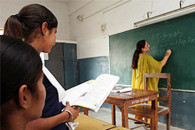Yasmeen Lari - the woman who taught Pakistan how to build for the poor
As the country’s first female architect, Lari was constantly questioned on her judgments and competence

Architect Yasmeen Lari.
PHOTO: KASHIF HUSSAIN
It is of no surprise then, you would think, that a woman of Lari’s stature would become the first female architect of Pakistan. Here, you would be wrong. For even Lari’s privileged upbringing did not allow her to escape the harsh realities of the patriarchal setup prevalent in the Indian subcontinent. Despite having qualified as an architect from the prestigious Oxford School of Architecture, Lari’s judgments and professional dealings were constantly questioned by contractors and even labourers on account of her gender.
A time of chaos
Today, Lari is best known for her unique approach to her work - the intersection of architecture and social justice. To understand her ideals, however, you would have to travel back in time to her early childhood days, which left a lasting impact on her personality.
Soon after Partition, Lari’s father, Zafarul Ahsan, was posted as the deputy commissioner of Lahore. It was a time of great misery and total anarchy, as hundreds of thousands of refugees travelled to either side of the border with little more than the clothes on their backs.
“There was a passion,” she reminisces, “in every person to do their bit for the country given to us by the Almighty.” Her parents, both actively involved in the relief work for migrants, would discuss the situation at home. Here is where Lari learnt her lessons of empathy.
“There was also anger,” she says, referring to the trains filled with bloodied corpses that pulled into the Lahore station. “People wanted to hurt those fleeing to India,” she remembers. “But my father always intervened in these situations.”
Her mother, meanwhile, would frequently visit the refugee camps and ask after the migrants. “It was winter season and people needed warm clothes and blankets.”
A privileged upbringing
Lari acquired her primary education from the Queen Mary’s School - one of the most prestigious institutions in the city. She then got enrolled in Adabistan-e-Soophia, where she got her first indoctrination in the Persian language. This institution, says Lari, served as her awakening to the prevalent conditions in the country and her responsibilities toward it.
After completing her studies at Adabistan-e-Soophia, she got admitted to the Kinnaird College in Lahore. She was in the second year of the intermediate level, when her father was posted as the head of Pakistan International Airlines. The posting gave ample opportunity for travel and the whole family, including Lari’s elder brother and two younger sisters, decide to move to London for better educational facilities.
Starting off in Karachi
In 1963, Lari graduated from the Oxford School of Architecture. “I had developed an interest in architecture, drawing inspiration from my father’s work as chairperson of the Lahore Improvement Trust and the Thal Development Authority,” she reminisces. “He often said that Pakistan needs many talented and highly educated professional architects,” she adds.
Soon after her graduation, she returned to Pakistan with her husband, Suhail Lari, whom she had wedded during the course of her studies in London.
The young couple moved to Karachi, where Yasmeen, now 23, opened her architecture firm, Lari Associates. In 1969, Lari became an elected Member of the Royal Institute of British Architects.
She had officially become the first female architect of Pakistan - a title that was initially more a curse than a blessing as the male-dominated industry was reluctant to accept her. “It was a time when young people were driven by a passion to serve the country and they returned to Pakistan after completing their education,” she says. “We had witnessed the sacrifices rendered to create Pakistan, which is why we valued it,” she adds.
In Karachi, the young couple busied themselves with the literary circle, rubbing shoulders with famous artists of the time such as Shakir Ali, Sadequain and Gul Jee, among others.
Few people know that Yasmeen Lari is an expert at playing the Sitar - a plucked stringed instrument, originating from the subcontinent and used in classical music. She is the first Pakistani woman to play the Sitar live for a BBC London show.
Preserving history: Heritage sites to be mapped
Early career
Lari kicked off her career by designing the houses of close relatives and friends. Her first project was her brother’s house. As her reputation grew, largely through word of mouth, she was commissioned more projects over the next few years. “Opportunities for young people, especially women, were quite limited at the time,” she says. Again, her family came to her assistance. “It wasn’t that difficult for me because I had my family’s support,” she says. In all, she designed around 24 houses.
Lari got her first big break when was commissioned by the Pakistan Navy to design a complex on Moulvi Tamizuddin Khan Road. Although she has always been a critic of high-rise buildings, saying they limit the social connection and are especially ill-suited for women, she undertook the project and gave it her own personal touch. The structure was designed keeping in mind the mobility of women and children.
This ideal was also reflected in her flagship project - the Anguri Bagh Housing scheme in Lahore, comprising 787 low-cost dwelling units arranged in 14 clusters of single, two-storey, and three-storey blocks.
She has since been the brains behind some of the most iconic buildings in Karachi, including the Taj Mahal Hotel in 1981, Finance and Trade Centre on Sharae Faisal in 1989 and the Pakistan State Oil House in 1991.
Social work
The Laris set up the Heritage Foundation in 1980, with the aim to preserve the cultural heritage that comes with structures of historic significance. Over the next 14 years, the NGO recorded over 600 historic buildings that required maintenance and preservation. “This was very hard work and required a lot of patience,” she smiles.
Finding these buildings, making their sketches and then collecting documents detailing their historical significance was an uphill task.
But their fervent efforts finally bore fruit when in 1994, the Sindh Cultural Heritage (Preservation) Act 1994 was approved for the preservation and this work was advanced through Sindh Culture Department. Now, the number of these protected buildings has reached 1,600.
Her efforts were recorded in the form of a book, ‘The Dual City: Karachi During the Raj’, by her son. The book features unique pictures of historical buildings of Karachi and their historic references. A guide book was also compiled in 2000 which included details of these heritage buildings.
Lari launched the Karavan Initiatives in 2001 in light of the book to raise awareness about these buildings. Sittings were organized on the city’s footpaths to highlight the importance of the cultural heritage. Hundreds turned up to these sessions. In fact, one session, within the boundary wall of the Empress Market drew a crowd numbering into the thousands.
Giving back
Since retiring from professional practice in 2000, Lari has undertaken a number of projects to improve the living conditions of the less-privileged strata of society.
“My most important project is the nature-friendly stove designed for the women of Makli [a small town in Sindh],” she says. “It is even more important than the FTC building because it improves the lives of the poor and improves the status of women,” she explains.
The stove reduces carbon emissions and it uses biological waste, instead of wood for burning. Its design incorporates safety standards for women and children and has been installed in over 40,000 homes to date.
Laari is also working to improve the living conditions of the beggars’ community in Makli under the Barefoot Village Entrepreneurs Programme. The scheme offers a clean room, bathroom and an environment-friendly stove for a family and a combined water supply facility shared between five such houses. Each house costs between Rs25,000 and Rs30,000, which is supported by several international NGOs, besides the Heritage Foundation. “The beggars’ community, which was spending their life under the open sky, is now able to live a better lifestyle and is also adopting different ways to earn,” she explains.
Currently, 231 residents of eight villages are being trained in the construction of such houses. These include 43 persons with disabilities. Once their training is complete, they will be the master trainers, who will impart their skills to others.
Karachi’s dilemma
According to Lari, it is the collective behavior of citizens that is responsible for the disproportional constructions and eradication of public spaces in Karachi. “There used to be more places to walk,” she recalls of Karachi in the 70s. “The construction style of houses was more spacious and people used to socialise in the streets and parks,” she adds.
But now, there is an abundance of cars and the government and city administration only focus to keep the flood of cars flowing. “Roads, underpasses and bridges are being constructed but spaces for citizens to socialise are becoming extinct,” she laments.
On the recent anti-encroachment drive being conducted in the city on the Supreme Court’s orders, Lari opined that it was a good effort to revive public spaces. “Some people are being affected by it, but it must be remembered that these places belong to everybody,” she reasons.
One of the major reasons for Karachi’s constant housing crisis is the influx of migrants from rural areas. “But this is not the people’s fault, she cautions. “It’s common across the world that port cities face population influx in the same manner,” she says.
But this requires proper town planning on the government’s part to ensure everyone has access to basic amenities. “Unfortunately, successive governments have never fulfilled this responsibility and slum areas emerged in the city,” she says. “Everyone has the right to live and find an income in Karachi but the illegal occupation of others’ places is not justifiable in any way,” says Lari. “There is a great contribution of corruption in it. This city is a generous city but the slum areas continued to expand due to absence of planning,” she adds.
For Lari, what Karachi needs is modern construction techniques and urban planning. She also has a suggestion for Prime Minister Imran Khan relating to the federal government’s plans to construct low-cost housing units. “Their estimate for each housing unit comes to around Rs1.5 million to Rs2m,” she says. “How can the poor afford this?” she questions, adding that her project provides housing for the less-privileged for a maximum of Rs30,000.
Architect par excellence
It is impossible to list Yasmeen Lari’s accomplishments on these pages or even describe her contributions to the field of architecture in Pakistan as well as her social work for the under-privileged. Her publications, ‘Slums and Squatter Settlements: Their Role and Improvement Strategy’ and ‘Our Heritage in Muslim Architecture’, just to name a few have enlightened thousands of young architects. Her work for the preservation of heritage buildings has at the very least raised awareness on a societal level and to a large extent, stopped their decay due to official apathy.
She has received numerous accolades from both local and international organisations. In 2002, the Heritage Foundation received the UN Recognition Award for its efforts to promote historical preservation. In 2006, Lari was awarded the Sitara-e-Imtiaz, one of the country’s highest civilian awards, in recognition of her services to the profession and for the conservation of heritage sites in Pakistan. In 2016, she received the prestigious Fukuoka Prize for Arts & Culture.
For Lari, however, her biggest reward is in Makli. When women improve their status in the community by making a living through the stove she designed. When the poor are able to sleep under a roof. This was what she learnt from her parents. This is what she has been striving for all these years.



















COMMENTS
Comments are moderated and generally will be posted if they are on-topic and not abusive.
For more information, please see our Comments FAQ